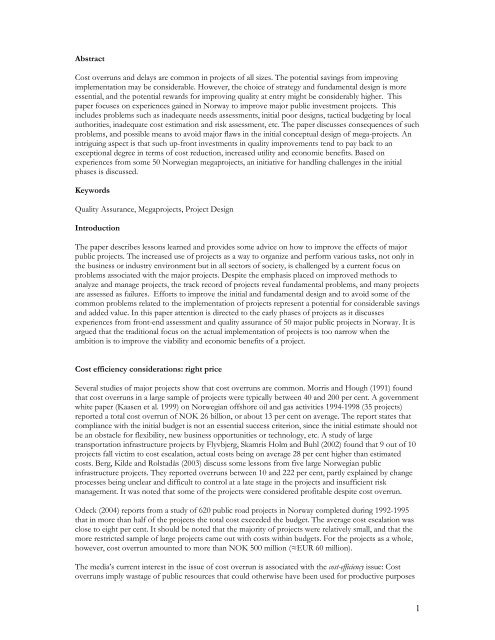Link to thesis. - Concept - NTNU
Link to thesis. - Concept - NTNU
Link to thesis. - Concept - NTNU
- No tags were found...
You also want an ePaper? Increase the reach of your titles
YUMPU automatically turns print PDFs into web optimized ePapers that Google loves.
AbstractCost overruns and delays are common in projects of all sizes. The potential savings from improvingimplementation may be considerable. However, the choice of strategy and fundamental design is moreessential, and the potential rewards for improving quality at entry might be considerably higher. Thispaper focuses on experiences gained in Norway <strong>to</strong> improve major public investment projects. Thisincludes problems such as inadequate needs assessments, initial poor designs, tactical budgeting by localauthorities, inadequate cost estimation and risk assessment, etc. The paper discusses consequences of suchproblems, and possible means <strong>to</strong> avoid major flaws in the initial conceptual design of mega-projects. Anintriguing aspect is that such up-front investments in quality improvements tend <strong>to</strong> pay back <strong>to</strong> anexceptional degree in terms of cost reduction, increased utility and economic benefits. Based onexperiences from some 50 Norwegian megaprojects, an initiative for handling challenges in the initialphases is discussed.KeywordsQuality Assurance, Megaprojects, Project DesignIntroductionThe paper describes lessons learned and provides some advice on how <strong>to</strong> improve the effects of majorpublic projects. The increased use of projects as a way <strong>to</strong> organize and perform various tasks, not only inthe business or industry environment but in all sec<strong>to</strong>rs of society, is challenged by a current focus onproblems associated with the major projects. Despite the emphasis placed on improved methods <strong>to</strong>analyze and manage projects, the track record of projects reveal fundamental problems, and many projectsare assessed as failures. Efforts <strong>to</strong> improve the initial and fundamental design and <strong>to</strong> avoid some of thecommon problems related <strong>to</strong> the implementation of projects represent a potential for considerable savingsand added value. In this paper attention is directed <strong>to</strong> the early phases of projects as it discussesexperiences from front-end assessment and quality assurance of 50 major public projects in Norway. It isargued that the traditional focus on the actual implementation of projects is <strong>to</strong>o narrow when theambition is <strong>to</strong> improve the viability and economic benefits of a project.Cost efficiency considerations: right priceSeveral studies of major projects show that cost overruns are common. Morris and Hough (1991) foundthat cost overruns in a large sample of projects were typically between 40 and 200 per cent. A governmentwhite paper (Kaasen et al. 1999) on Norwegian offshore oil and gas activities 1994-1998 (35 projects)reported a <strong>to</strong>tal cost overrun of NOK 26 billion, or about 13 per cent on average. The report states thatcompliance with the initial budget is not an essential success criterion, since the initial estimate should notbe an obstacle for flexibility, new business opportunities or technology, etc. A study of largetransportation infrastructure projects by Flyvbjerg, Skamris Holm and Buhl (2002) found that 9 out of 10projects fall victim <strong>to</strong> cost escalation, actual costs being on average 28 per cent higher than estimatedcosts. Berg, Kilde and Rolstadås (2003) discuss some lessons from five large Norwegian publicinfrastructure projects. They reported overruns between 10 and 222 per cent, partly explained by changeprocesses being unclear and difficult <strong>to</strong> control at a late stage in the projects and insufficient riskmanagement. It was noted that some of the projects were considered profitable despite cost overrun.Odeck (2004) reports from a study of 620 public road projects in Norway completed during 1992-1995that in more than half of the projects the <strong>to</strong>tal cost exceeded the budget. The average cost escalation wasclose <strong>to</strong> eight per cent. It should be noted that the majority of projects were relatively small, and that themore restricted sample of large projects came out with costs within budgets. For the projects as a whole,however, cost overrun amounted <strong>to</strong> more than NOK 500 million (≈EUR 60 million).The media’s current interest in the issue of cost overrun is associated with the cost-efficiency issue: Cos<strong>to</strong>verruns imply wastage of public resources that could otherwise have been used for productive purposes1
















